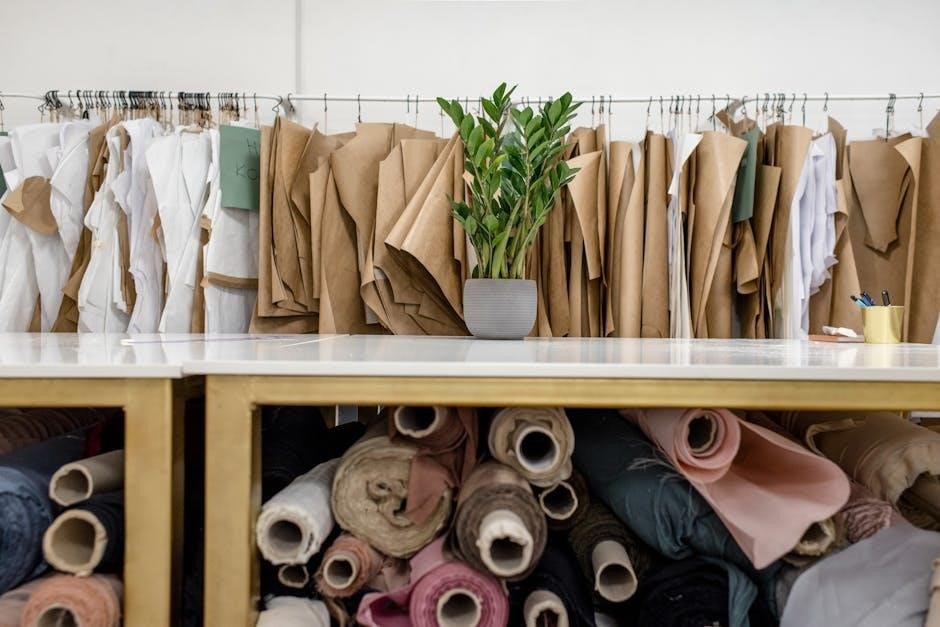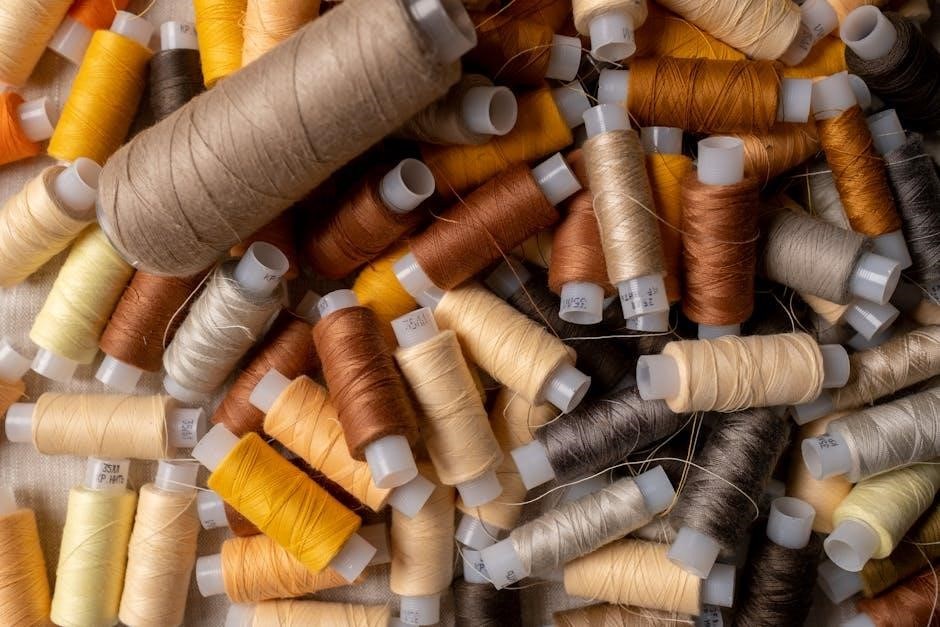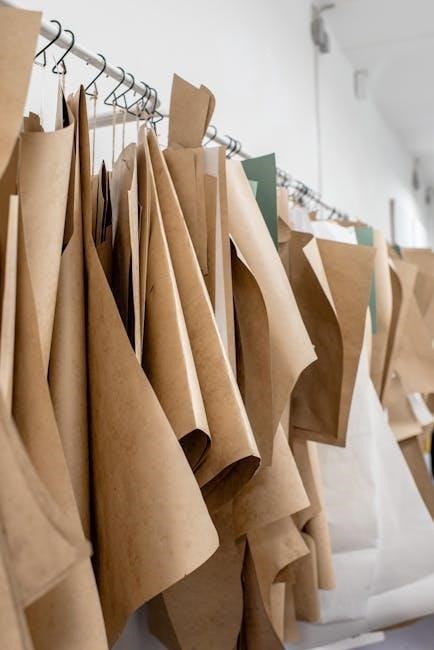Discover the world of DIY bag making with versatile PDF sewing patterns. Perfect for all skill levels, these designs offer creativity and accessibility, helping you craft unique bags effortlessly.
Popularity of DIY Bag Making
DIY bag making has surged in popularity as crafters embrace creativity and sustainability. With accessible PDF patterns, sewists can craft unique, customizable bags at home. From stylish totes to practical backpacks, the variety of designs caters to all skill levels. Free and paid patterns offer flexibility, allowing beginners to start small while experienced makers explore complex projects. The ability to choose fabrics and personalize details makes each bag a one-of-a-kind creation, appealing to eco-conscious and fashion-forward enthusiasts alike. This trend encourages self-expression and skill development, making bag sewing a rewarding and enjoyable hobby for many.
Why Use PDF Sewing Patterns?
PDF sewing patterns offer unmatched convenience and flexibility for bag making. Instant downloads eliminate waiting, allowing projects to start immediately. Printable at home on standard paper sizes, they save time and space. Many patterns are free, making them accessible to all. Reusable and easily shared, PDFs are ideal for beginners and experienced sewists. They often include step-by-step instructions, ensuring a smooth sewing process. Whether for totes, purses, or backpacks, PDF patterns provide a cost-effective, eco-friendly alternative to traditional paper patterns, making DIY bag creation more accessible and enjoyable than ever.

Types of Bag Sewing Patterns Available
Explore diverse bag sewing patterns, from simple totes to elegant purses and functional backpacks. PDF formats offer versatility, catering to various skill levels and design preferences.
Tote Bag Sewing Patterns
Tote bags are a popular choice for sewists, offering versatility and practicality. With free PDF sewing patterns available, you can create custom totes tailored to your needs. Ideal for beginners, these patterns often feature simple designs that require minimal fabric, such as denim, canvas, or cotton drill. Whether you’re making a sturdy work tote or a stylish everyday bag, PDF patterns provide clear instructions for a professional finish. Many patterns also include options for pockets or adjustable straps, allowing for personalization. Tote bag sewing is a great way to practice essential skills while creating something useful and stylish.
Purse and Handbag Sewing Patterns
Purse and handbag sewing patterns are perfect for creating stylish, functional accessories. With numerous free PDF sewing patterns available, you can craft everything from elegant clutches to practical shoulder bags. Designs often cater to all skill levels, offering step-by-step instructions for beginners. Fabrics like denim, canvas, or cotton drill are ideal for durability. Many patterns include features like pockets, zippers, and adjustable straps, allowing for customization. Whether you’re making a simple pouch or a sophisticated handbag, these patterns provide the tools to create professional-looking results. They’re a great way to experiment with embroidery or decorative elements for a personalized touch.
Backpack and Laptop Bag Sewing Patterns
Backpack and laptop bag sewing patterns are ideal for creating functional and stylish bags. These PDF designs cater to various needs, from everyday use to travel. Patterns often include features like padded laptop compartments, multiple pockets, and reinforced straps for durability. Suitable for all skill levels, they offer step-by-step guides for sewing sturdy bags. Recommended fabrics include denim, canvas, or heavy-duty cotton for long-lasting results. Many patterns are free to download, allowing you to craft custom bags tailored to your preferences. Whether for school, work, or outdoor adventures, these patterns help you create practical and professional-looking bags with ease.

Where to Find Free Bag Sewing Patterns PDF
Discover free bag sewing patterns PDF on platforms like Pinterest, Craftsy, and Etsy. These websites offer a variety of designs, perfect for both beginners and experienced sewists.
Curated Lists of Free Bag Patterns
Explore curated lists of free bag sewing patterns PDF on platforms like Pinterest, Craftsy, and AllFreeSewing. These collections feature diverse designs, from simple totes to complex backpacks. Many bloggers and sewing communities compile these lists, ensuring high-quality and versatile options. They often include filters by skill level, bag type, or fabric requirements. Regularly updated, these lists are perfect for discovering new projects. Use search terms like “best free bag sewing patterns” or “DIY bag tutorials” to find these resources. They’re a great starting point for sewists seeking inspiration or specific styles to match their skill level and creative vision.
Popular Websites for Free Downloads
Discover free bag sewing patterns PDF on websites like Craftsy, Pinterest, and Etsy. These platforms offer a wide range of downloadable designs, from tote bags to backpacks. Craftsy provides detailed tutorials, while Pinterest showcases user-friendly designs. Etsy often includes unique, indie patterns. AllFreeSewing and Sewing Parts Online also curate free bag patterns. These sites cater to all skill levels, ensuring versatility for beginners and experienced sewists. Use filters like “free PDF” or “bag sewing patterns” to find exactly what you need. These resources make it easy to start your DIY bag-making journey with high-quality, accessible designs.

Fabric Requirements for Bag Sewing
Selecting the right fabric is crucial for durability and aesthetics. Cotton, canvas, and denim are popular choices for bags due to their strength and versatility.
Recommended Fabrics for Bag Making
Cotton and linen are ideal for casual, lightweight bags, while canvas and denim offer durability for sturdy designs. Nylon or vinyl fabrics are perfect for water-resistant options, and leather adds a luxurious touch. Consider fabric weight, texture, and purpose when selecting materials. Medium-weight fabrics like twill or cordura are great for structured bags, while quilting cotton works well for patchwork designs. Blending fabrics can enhance functionality and aesthetics, ensuring your bag is both practical and visually appealing. Always prewash fabrics to prevent shrinkage and ensure a professional finish.
How to Choose the Right Material

Selecting the right fabric for your bag involves considering its purpose, durability, and aesthetic appeal. Assess the weight and structure needed—lighter fabrics for casual bags, heavier ones for sturdy designs. Consider the pattern’s recommendations to ensure compatibility. Think about texture and color to match your personal style. Durability is key for everyday use, while decorative fabrics can add unique flair. Always check the fabric’s care instructions and ensure it aligns with your project’s requirements. Pre-washing fabrics is essential to avoid shrinkage and ensure a professional finish.

Tools and Supplies Needed
To create a professional-looking bag, you’ll need a sewing machine, sharp scissors, rotary cutter, ruler, seam ripper, pins, zipper foot, walking foot, and heavy-duty thread. These tools ensure precise cutting, smooth stitching, and a polished finish. Include interfacing and stabilizers to add structure and durability to your bag. Always have a well-stocked sewing kit on hand to tackle any project confidently.
Essential Sewing Tools for Bag Making
Accurate cutting tools like rotary cutters and mats are vital for precise fabric preparation. Sharp scissors and a reliable sewing machine with a zipper or Teflon foot are must-haves. A walking foot helps manage thick fabrics and heavy-duty threads. A seam gauge ensures consistent seams, while a ruler guides straight cuts. Clips and pins keep fabric layers secure, and a seam ripper corrects mistakes. Interfacing and stabilizers add structure. These tools ensure professional results, making bag sewing efficient and enjoyable. Invest in quality tools to achieve clean finishes and durable bags.
Interfacing and Stabilizers for Professional Results
Interfacing and stabilizers are crucial for adding structure and stability to your bags. Fusible interfacing is ideal for lining fabrics, while sew-in interfacing offers durability without adhesion. Stabilizers like Peltex or Decovil provide rigid support, perfect for bag bottoms or laptop sleeves. These materials prevent fabric stretching and ensure crisp, professional finishes. Choose the right weight based on your bag’s intended use. Properly fusing or sewing these materials ensures long-lasting results. They elevate your creations from homemade to high-end, making them both functional and visually appealing. Use them strategically to achieve a polished, professional look in your bag-making projects.

Step-by-Step Sewing Guides

Step-by-step sewing guides provide comprehensive instructions for bag making, ensuring clarity and ease of execution. They break down complex projects into manageable steps, making sewing accessible to all skill levels. Detailed patterns, measurements, and tutorials are included to enhance understanding. These guides are designed to help sewists achieve professional results, whether they’re creating simple totes or intricate designs. By following these structured plans, anyone can craft beautiful, functional bags with confidence and precision, improving their sewing skills along the way.
Beginner-Friendly Tutorials for Bag Sewing
Beginner-friendly tutorials for bag sewing are designed to guide new sewists through simple, step-by-step projects. These tutorials are ideal for those unfamiliar with sewing patterns, offering clear instructions and visual aids. They often focus on basic bag styles, such as tote bags or small pouches, using straightforward techniques. Many include tips for cutting fabric accurately, sewing straight lines, and finishing seams. These resources are perfect for building confidence and foundational skills. By following these guides, beginners can create functional and stylish bags while learning essential sewing principles. Practice with scrap fabric is encouraged to master each step before working on final projects.
Advanced Techniques for Customization
Advanced techniques for customization allow sewists to elevate their bag-making projects. These methods include intricate details like zippered pockets, adjustable straps, and reinforced seams. Adding unique closures, such as magnetic snaps or buckles, enhances functionality. Experienced sewists can also experiment with embroidery, appliqué, or quilting for decorative touches. Modifying patterns to add compartments or alter shapes provides endless personalization options. Using contrasting fabrics for linings or accents adds a professional finish. These techniques empower creators to design one-of-a-kind bags tailored to their preferences or specific uses, ensuring each project stands out with a custom, high-end appearance.

Tips for Perfecting Seams and Finishes
Perfecting seams and finishes is essential for professional-looking bags. Press seams as you sew to ensure crisp folds and flat construction. Use a walking foot or Teflon foot for smooth fabric handling, especially with thick materials. Topstitching adds durability and a polished appearance. Trim seam allowances carefully and grade them to prevent bulk. For clean edges, use a serger or zigzag stitch on raw edges before sewing. Backstitch at the start and end of seams for strength. Finally, press the entire bag after assembly to set the seams and achieve a professional finish. These steps ensure sturdy, long-lasting bags with a tailored look.
Customization and Personalization Ideas
Customize your bags with unique pockets, contrasting fabrics, or embroidery. Add decorative elements like appliques or hardware. Personalize with monograms or colorful accents for a professional finish.
Adding Pockets and Compartments
Add functionality and style with pockets and compartments. Incorporate zipper pockets for security or slip pockets for easy access. Use contrasting fabrics for a decorative touch. Position pockets strategically, inside or outside, based on the bag’s purpose. Add magnetic snaps or Velcro for closure. Measure carefully to ensure seams align perfectly. Reinforce with interfacing for durability. Customize compartment sizes to fit specific items like phones or laptops. This detail enhances usability and makes your handmade bag truly unique and practical for everyday use.
Embroidery and Decorative Elements
Enhance your bag’s personality with embroidery and decorative elements. Add intricate designs, monograms, or patterns using hand-stitching or machine embroidery. Incorporate appliques, patches, or ribbon accents for a unique touch. Use contrasting thread colors to make designs pop. Stabilize fabric with interfacing for smooth embroidery. Experiment with beadwork or sequins for added sparkle. Pre-designed embroidery templates are available in PDF patterns, making it easy to achieve professional results. These elements allow for endless customization, turning your handmade bag into a one-of-a-kind creation that reflects your personal style and creativity.

Popular Bag Sewing Patterns for All Skill Levels
Discover popular bag sewing patterns tailored for all skill levels. From simple totes to stylish backpacks, find designs that match your expertise. Perfect for any sewer.
Patterns for Beginners
Perfect for those new to sewing, beginner-friendly bag patterns offer simplicity and clear instructions. Tote bags, pouches, and small clutches are ideal projects. These patterns typically require minimal pieces and straightforward construction. Many include step-by-step guides, making it easy to follow along. Look for designs with large, easy-to-read print options and fabric requirements that work with common materials like cotton or muslin. These patterns are designed to build confidence and skills, allowing new sewists to create functional and stylish bags without overwhelming complexity. Start with simple stitching and basic techniques to lay a strong foundation for more advanced projects.
Patterns for Intermediate and Advanced Sewists
For sewists with more experience, intermediate and advanced bag patterns offer complexity and sophistication. These designs often feature intricate details, such as multiple compartments, zippers, or adjustable straps. Patterns may include specialized techniques like baguette stitching or curved seams. Advanced designs might incorporate unique shapes, asymmetrical lines, or innovative closures. Many PDF patterns cater to skilled sewists, providing detailed instructions for professional finishes. They often include options for customization, allowing for personalized touches. These patterns are perfect for those looking to challenge their skills and create high-quality, tailored bags that showcase their expertise and creativity.
Creating your own bags is a rewarding craft. With countless PDF patterns and resources available, you can easily start sewing your own bags today and enjoy the satisfaction of handmade creation! Happy sewing!
Final Thoughts on Bag Sewing Patterns PDF
Bag sewing patterns in PDF format offer endless creativity and convenience for sewists of all levels. From simple totes to intricate handbags, these patterns provide clear instructions and versatility. With the ability to print and reuse them, PDFs are a practical choice for crafting unique, personalized bags. Whether you’re a beginner or an experienced sewer, these patterns empower you to create functional and stylish accessories. Embrace the joy of DIY bag making and explore the countless designs available online to bring your creative vision to life with ease and precision.
Encouragement to Start Sewing Your Own Bags
Embark on the rewarding journey of sewing your own bags—a hobby that combines creativity, practicality, and personal satisfaction. With bag sewing patterns in PDF, you can easily access guides tailored to your skill level. Whether you’re crafting a simple tote or a stylish handbag, sewing your own bags allows you to personalize designs, save money, and enjoy the pride of creating something unique. Don’t hesitate to begin; even small projects can lead to remarkable results. Gather your tools, choose a pattern, and let your imagination shine through every stitch!
